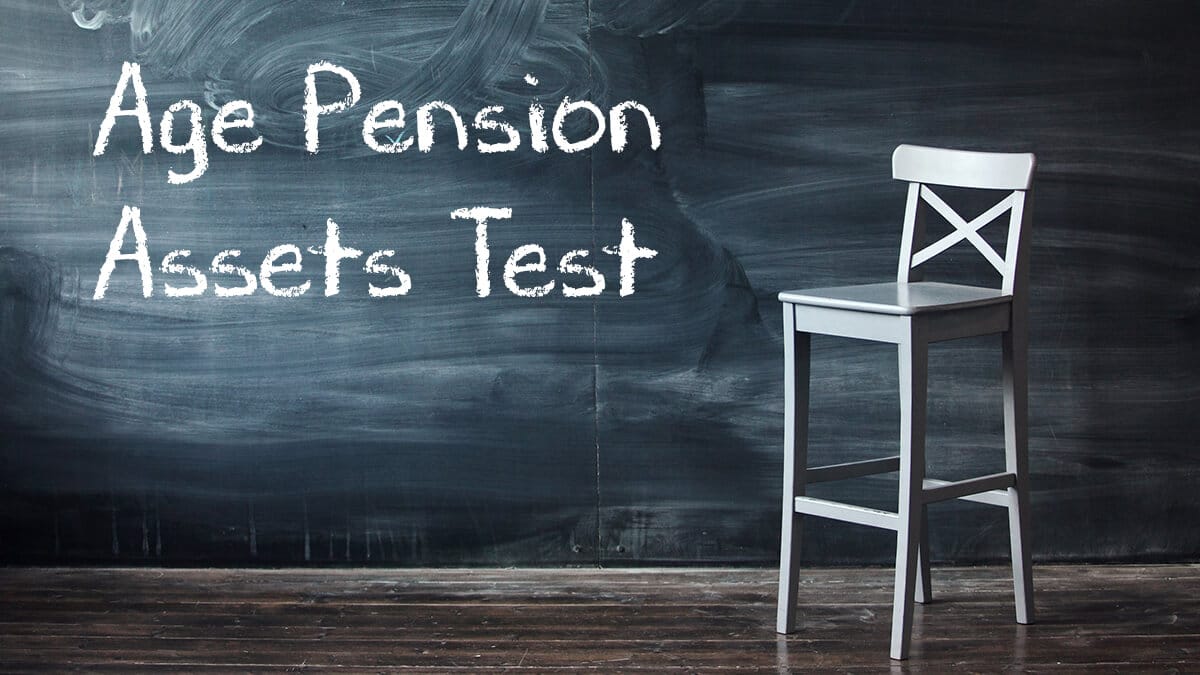In this guide
A common question for people nearing or in retirement is ‘How much money can I have before it affects my pension?’. The answer lies in the total value of your savings and other assets and your income from various sources.
This article details the rules of the Age Pension assets test (often mistakenly called the ‘asset test’), which is one half of the means test used by Centrelink to determine how much Age Pension you could be eligible for.
You must also pass the Age Pension income test, have reached your eligibility age and satisfy Australian residency rules.
Statistics consistently indicate that more retirees pass the Age Pension assets test than the income test. According to the Centre of Excellence in Population Ageing Research (CEPAR), only one third of Australians receiving part pensions have too much assessable wealth (assets) to be eligible for the full pension. The other two thirds are ineligible to receive the full pension because they earn too much income. CEPAR research also reveals that 54% of full pensioners have assessable assets worth below $50,000.
How does the Age Pension assets test work?
The market value of any assets you or your partner own will be assessed by Centrelink to determine your potential eligibility for the Age Pension.
According to research by the ANU Centre for Social Research and Methods, 73% of households with at least one Age Pensioner are homeowners and 17.6% of these households have a home worth more than $1 million.

Free eBook
Retirement planning for beginners
Our easy-to-follow guide walks you through the fundamentals, giving you the confidence to start your own retirement plans.
"*" indicates required fields
Any debts owing on assets other than your home is subtracted from their market value for the purposes of your assets test assessment. For example, if you have an investment property valued at $600,000 and you still owe $200,000 to the bank for the loan you obtained to buy it, the value of your investment property asset will be assessed at $400,000.
To be eligible for either a full or part Age Pension, there are limits on the value of the assets you (and your partner combined) can own. The limits depend on whether you own your own home, as well as your living arrangements (including if you have a partner and whether they are age-eligible for the pension or not). The asset limits are higher for non-homeowners in recognition of the higher cost of housing for pensioners who rent their home.
The current asset limits are itemised in the tables below. To be eligible for a full Age Pension the value of your assets must be below the following thresholds.
Age Pension asset limits
Assets limits for a full Age Pension
| Situation | Latest limit | Previous limit | Increase | |
|---|---|---|---|---|
| Single | Homeowner | $321,500 | $314,000 | $7,500 |
| Single | Non-homeowner | $579,500 | $566,000 | $13,500 |
| Couple (combined) | Homeowner | $481,500 | $470,000 | $11,500 |
| Couple (combined) | Non-homeowner | $739,500 | $722,000 | $17,500 |
- Latest limits apply 1 July 2025 to 30 June 2026
- Previous limits apply 1 July 2024 to 30 June 2025
Source: Services Australia
If the value of our assets is above the thresholds in the above table, you may still be eligible for a part Age Pension. The table below shows the maximum values of assets you can hold to still be eligible to receive any part-pension payment.
The amount of Age Pension you are eligible for reduces by $3 per fortnight per $1,000 of assets until it cuts off completely when the value of your assets exceeds the figures below.
Assets limits for a part Age Pension (residents)
| Situation | Latest limit | Previous limit | Increase | |
|---|---|---|---|---|
| Single | Homeowner | $714,500 | $704,500 | $10,000 |
| Single | Non-homeowner | $972,500 | $962,500 | $10,000 |
| Couple (combined) | Homeowner | $1,074,000 | $1,059,000 | $15,000 |
| Couple (combined) | Non-homeowner | $1,332,000 | $1,317,000 | $15,000 |
| Couple (illness-separated, combined) | Homeowner | $1,267,500 | $1,247,500 | $20,000 |
| Couple (illness-separated, combined) | Non-homeowner | $1,525,500 | $1,505,500 | $20,000 |
- Latest limits apply 20 September 2025 to 19 March 2026
- Previous limits apply 1 July 2025 to 19 September 2025
Source: Services Australia
To illustrate how the Age Pension rate decreases based on the value of assets, below are some examples of the current Age Pension payments that Australians should be eligible for at a range of different asset levels, provided they also meet the other eligibility requirements (age, passing the income test and Australian residency).
Click each example name to view.
2026 SMSF calendar
Our free calendar includes due dates for important documents plus suggested dates for trustee meetings and other strategic issues for your SMSF.
"*" indicates required fields
Example 1: Single homeowner
| Assets value | Age Pension payment (per fortnight) | Age Pension payment (per year) |
|---|---|---|
| $321,500 | $1,178.70 | $30,646 |
| $325,000 | $1,168.20 | $30,373 |
| $350,000 | $1,093.20 | $28,423 |
| $375,000 | $1,018.20 | $26,473 |
| $400,000 | $943.20 | $24,523 |
| $425,000 | $868.20 | $22,573 |
| $450,000 | $793.20 | $20,623 |
| $475,000 | $718.20 | $18,673 |
| $500,000 | $643.20 | $16,723 |
| $525,000 | $568.20 | $14,773 |
| $550,000 | $493.20 | $12,823 |
| $575,000 | $418.20 | $10,873 |
| $600,000 | $343.20 | $8,923 |
| $625,000 | $268.20 | $6,973 |
| $650,000 | $193.20 | $5,023 |
| $675,000 | $118.20 | $3,073 |
| $700,000 | $43.20 | $1,123 |
Example 2: Single non-homeowner
| Assets value | Age Pension payment (per fortnight) | Age Pension payment (per year) |
|---|---|---|
| $579,500 | $1,178.70 | $30,646 |
| $550,000 | $1,267.20 | $32,947 |
| $575,000 | $1,192.20 | $30,997 |
| $600,000 | $1,117.20 | $29,047 |
| $625,000 | $1,042.20 | $27,097 |
| $650,000 | $967.20 | $25,147 |
| $675,000 | $892.20 | $23,197 |
| $700,000 | $817.20 | $21,247 |
| $725,000 | $742.20 | $19,297 |
| $750,000 | $667.20 | $17,347 |
| $775,000 | $592.20 | $15,397 |
| $800,000 | $517.20 | $13,447 |
| $825,000 | $442.20 | $11,497 |
| $850,000 | $367.20 | $9,547 |
| $875,000 | $292.20 | $7,597 |
| $900,000 | $217.20 | $5,647 |
| $925,000 | $142.20 | $3,697 |
| $950,000 | $67.20 | $1,747 |
Example 3: Couple homeowner (combined)
| Assets value | Age Pension payment (per fortnight) | Age Pension payment (per year) |
|---|---|---|
| $481,500 | $1,777.00 | $46,202 |
| $500,000 | $1,721.50 | $44,759 |
| $525,000 | $1,646.50 | $42,809 |
| $550,000 | $1,571.50 | $40,859 |
| $575,000 | $1,496.50 | $38,909 |
| $600,000 | $1,421.50 | $36,959 |
| $625,000 | $1,346.50 | $35,009 |
| $650,000 | $1,271.50 | $33,059 |
| $675,000 | $1,196.50 | $31,109 |
| $700,000 | $1,121.50 | $29,159 |
| $725,000 | $1,046.50 | $27,209 |
| $750,000 | $971.50 | $25,259 |
| $775,000 | $896.50 | $23,309 |
| $800,000 | $821.50 | $21,359 |
| $825,000 | $746.50 | $19,409 |
| $850,000 | $671.50 | $17,459 |
| $875,000 | $596.50 | $15,509 |
| $900,000 | $521.50 | $13,559 |
| $925,000 | $446.50 | $11,609 |
| $950,000 | $371.50 | $9,659 |
| $975,000 | $296.50 | $7,709 |
| $1,000,000 | $221.50 | $5,759 |
| $1,025,000 | $146.50 | $3,809 |
| $1,050,000 | $71.50 | $1,859 |
Example 4: Couple non-homeowner (combined)
| Assets value | Age Pension payment (per fortnight) | Age Pension payment (per year) |
|---|---|---|
| $739,500 | $1,777.00 | $46,202 |
| $700,000 | $1,895.50 | $49,283 |
| $725,000 | $1,820.50 | $47,333 |
| $750,000 | $1,745.50 | $45,383 |
| $775,000 | $1,670.50 | $43,433 |
| $800,000 | $1,595.50 | $41,483 |
| $825,000 | $1,520.50 | $39,533 |
| $850,000 | $1,445.50 | $37,583 |
| $875,000 | $1,370.50 | $35,633 |
| $900,000 | $1,295.50 | $33,683 |
| $925,000 | $1,220.50 | $31,733 |
| $950,000 | $1,145.50 | $29,783 |
| $975,000 | $1,070.50 | $27,833 |
| $1,000,000 | $995.50 | $25,883 |
| $1,025,000 | $920.50 | $23,933 |
| $1,050,000 | $845.50 | $21,983 |
| $1,075,000 | $770.50 | $20,033 |
| $1,100,000 | $695.50 | $18,083 |
| $1,125,000 | $620.50 | $16,133 |
| $1,150,000 | $545.50 | $14,183 |
| $1,175,000 | $470.50 | $12,233 |
| $1,200,000 | $395.50 | $10,283 |
| $1,225,000 | $320.50 | $8,333 |
| $1,250,000 | $245.50 | $6,383 |
| $1,275,000 | $170.50 | $4,433 |
| $1,300,000 | $95.50 | $2,483 |
| $1,325,000 | $20.50 | $533 |
Assets limits for a part Age Pension (non-residents)
The assets limits for non-residents are slightly lower and summarised in the table below.
| Situation | Latest limit | Previous limit | Increase | |
|---|---|---|---|---|
| Single | Homeowner | $691,250 | $681,750 | $9,500 |
| Single | Non-homeowner | $949,250 | $939,750 | $9,500 |
| Couple (combined) | Homeowner | $1,040,500 | $1,026,000 | $14,500 |
| Couple (combined) | Non-homeowner | $1,298500 | $1,284,000 | $14,500 |
| Couple (illness-separated, combined) | Homeowner | $1,221,000 | $1,202,000 | $19,000 |
| Couple (illness-separated, combined) | Non-homeowner | $1,479,000 | $1,460,000 | $19,000 |
- Latest limits apply 20 September 2025 to 19 March 2026
- Previous limits apply 1 July 2025 to 19 September 2025
Source: Services Australia
The Age Pension assets limits are adjusted three times a year based on movements in the consumer price index (CPI). The thresholds for the full Age Pension change in July, while thresholds for the part Age Pension change in March and September.
Assets limits for a transitional part Age Pension (residents)
Some Age Pensioners in Australia are on transitional pensions. Transitional pensions rates are paid to people who would otherwise be getting a lower payment when changes to the income test were introduced in 2009. From 20 March 2020, transitional rate pensions cancel when your assets are more than the limit for your situation.
The table below shows the asset value cut-off points for receiving a transitional pension.
| Situation | Latest limit | Previous limit | Increase | |
|---|---|---|---|---|
| Single | Homeowner | $641,500 | $636,500 | $5,000 |
| Single | Non-homeowner | $899,500 | $894,500 | $5,000 |
| Couple (combined) | Homeowner | $998,000 | $990,000 | $8,000 |
| Couple (combined) | Non-homeowner | $1,256,000 | $1,248,000 | $8,000 |
| Couple (illness-separated, combined) | Homeowner | $1,121,500 | $1,111,500 | $10,000 |
| Couple (illness-separated, combined) | Non-homeowner | $1,379,500 | $1,369,500 | $10,000 |
- Latest limits apply 20 September 2025 to 19 March 2026
- Previous limits apply 1 July 2025 to 19 September 2025
Source: Services Australia
Assets limits for a transitional part Age Pension (non-residents)
| Situation | Latest limit | Previous limit | Increase | |
|---|---|---|---|---|
| Single | Homeowner | $610,750 | $606,000 | $4,750 |
| Single | Non-homeowner | $868,750 | $864,000 | $4,750 |
| Couple (combined) | Homeowner | $965,000 | $957,000 | $8,000 |
| Couple (combined) | Non-homeowner | $1,223,000 | $1,215,000 | $8,000 |
| Couple (illness-separated, combined) | Homeowner | $1,060,000 | $1,050,500 | $9,500 |
| Couple (illness-separated, combined) | Non-homeowner | $1,318,000 | $1,308,500 | $9,500 |
- Latest limits apply 20 September 2025 to 19 March 2026
- Previous limits apply 1 July 2025 to 19 September 2025
Source: Services Australia
What is included in the Age Pension assets test?
Assets that you or your partner may own that will be included in your assets test include any of the following:

Free eBook
How to maximise your Age Pension
Learn tips that help you make the most of the Age Pension so your retirement savings last longer.
"*" indicates required fields
- Real estate (excluding your family home). For example, investment properties or a granny flat that you own on a property that belongs to someone else
- Household contents. It’s important to note that even though the market value of your family home is excluded from the assets test, the market value of any of your household contents (such as furniture and appliances) is included. The market value of these items is what you would get for them if you sold them in their current condition, not what you paid for them
- Superannuation balances if both you and your partner have reached the Age Pension eligibility age, including the balance of your pension accounts that provide you with an income stream. If your partner is below the Age Pension eligibility age, their super balances will not be included in your assets test
- Other financial investments, like term deposits or any surrender value of life insurance policies
- Retirement village contributions
- Business assets
- Motor vehicles
- Boats
- Caravans
- Jewellery
- Cryptocurrencies
Can you give some of your assets away to get under the assets test threshold?
Yes, you and your partner can do this, but there are limits to the value of the assets you can give away before your Age Pension will be affected.
Also be aware that you don’t necessarily have to give away an asset for free for it to be considered a gift. Assets transferred for less than their market value are also considered to be gifts in terms of the discount provided.
Centrelink will assess any gifts you make over a five-year period and count them towards your assets test for five years. You can gift assets worth more up to $10,000 in any one financial year and $30,000 over any five-year period without the gifted assets being subject to the assets test. Gifts in excess of these amounts will be assessed and the deeming rate will also be applied to the excess for the purposes of your income test.
What if you or your partner own assets overseas?
These assets will be included in your assets test. The overseas value of the assets will be the amounts converted to an equivalent Australian dollar value using current exchange rates.
What happens if the value of your assets changes?
If you’re receiving a full or part Age Pension, you need to inform Centrelink of any changes to the value of you or your partner’s assets within 14 days. For example, when you buy new assets or sell existing ones, because this will increase or decrease the total value of your assets.
Centrelink will then reassess your correct Age Pension entitlement. If you’ve been overpaid the Age Pension since the value of your assets has increased, you’ll be required to repay the excess amount. On the other hand, if you’ve been underpaid, you may be reimbursed.
Hardship provisions
If you’re suffering severe financial hardship and the value of your assets is either preventing you from getting any Age Pension or you’re receiving a reduced amount, you can apply to Centrelink to review your eligibility.
Centrelink will use the following criteria when assessing your claim:
Manage your retirement savings with confidence – for free

Get practical guidance from independent experts to help you make the most of your finances in retirement with a free SuperGuide account.
Find out more- You own an asset that is difficult to sell
- You can’t borrow against the asset’s value
- You qualify for the Age Pension under the income test
- Your current total income is less than the full Age Pension rate
- There is nothing else you can reasonably do to improve your financial circumstances.
The maximum amount of Age Pension you can currently access under the hardship provision is $26,689.00 for singles and $40,237.60 for couples. These amounts are adjusted in March and September each year based on movements in the consumer price index (CPI). The CPI is calculated quarterly by the Australian Bureau of Statistics.
How the Age Pension assets and income tests work together
If you reach the threshold limits in both the assets and income tests, your pension will be based on the lower amount.
For example, if you are eligible for $400 per fortnight according to the assets test, and $500 per fortnight under the income test, then the $400 per fortnight test will apply.



Leave a Reply
You must be logged in to post a comment.